
Well, I’ve finally had to buy a new camera. If a camera can survive hanging around my neck in the woods for 4-5 years it’s a tough camera, and the two Cannon PowerShot SX-40s I’ve used for several years performed admirably. But I’ve worn out both of them, so this time I went with the Cannon PowerShot SX-70. These cameras are “bridge cameras,” so called because they bridge the gap between a DSLR and a Point and shoot. This one has a 65X optical zoom with a 20.3 Megapixel CMOS sensor and DIGIC 8 Image processor. In my style of nature study I can’t be carrying a bag full of heavy lenses with me while I crawl around on the forest floor. I want to be ready for anything at any time, and this camera has the finesse it takes for shots of insects as well as the reach it takes for shots of animals. My line of thought is, since I don’t “do” birds I don’t need the great reach of a $5,000.00, 600 mm lens but as you will see in this post, I was going to do birds. Or more accurately, birds were going to do me.
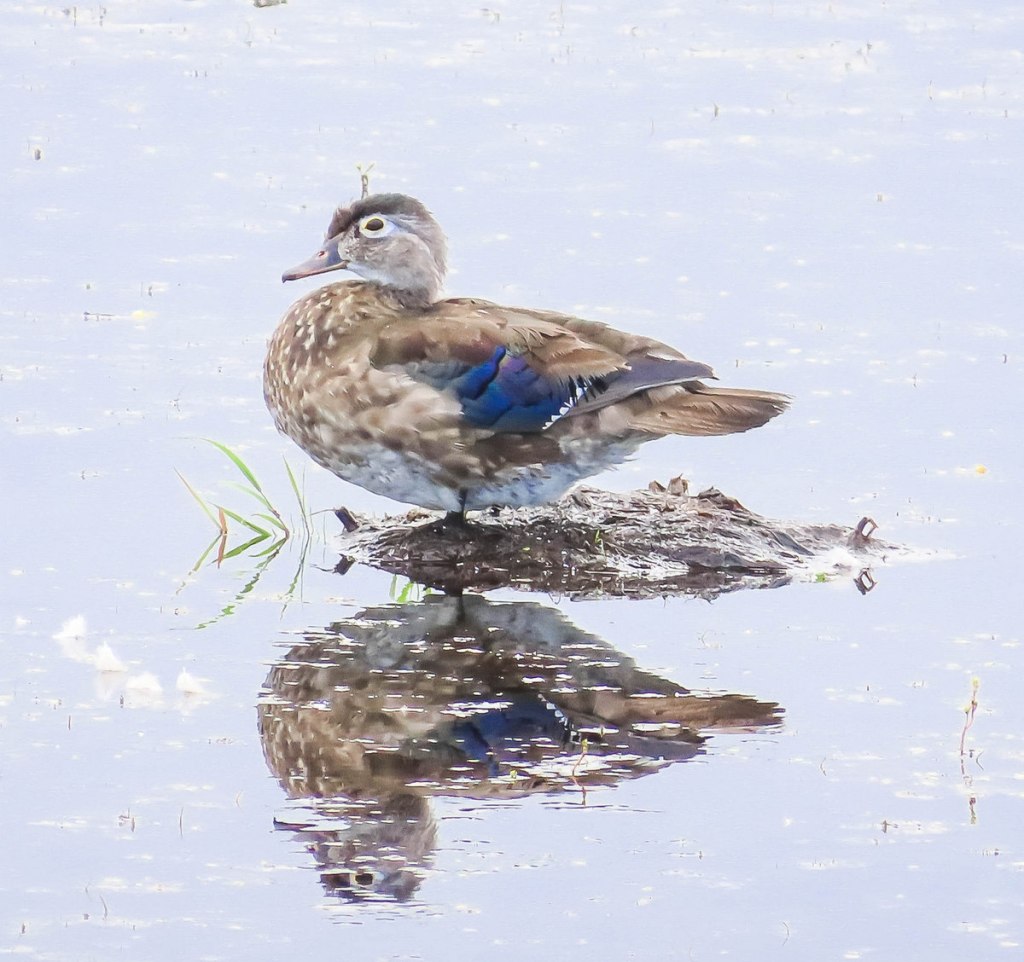
This is the first “blog worthy” shot I took with the new camera: a female wood duck. This encounter was strange, since wood ducks don’t usually sit still and let me take photos. They swim or fly away at top speed. Or they used to anyway. This one just sat on its tiny island and let me move as close as I could and I was happy that it did, because it’s only the second shot I’ve gotten of a wood duck. I love their chubby little cheeks and their beautiful colors. Though the females are pretty the males are amazing, and I hope to get a photo of one of them someday.
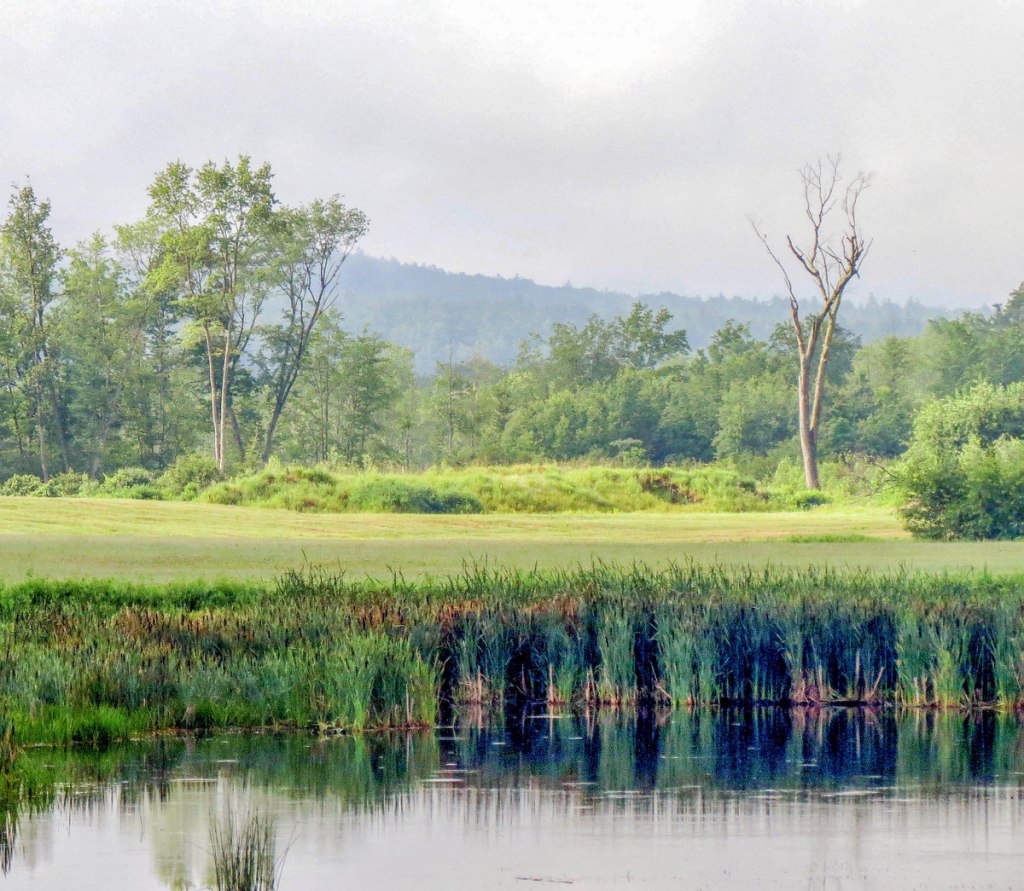
I was back in the wetlands when I saw the wood duck. This is a shot I took a while ago with my old Cannon SX-40. I like its dreamy, impressionistic appearance but you don’t always want dreamy and impressionistic; sometimes you want sharp. In any event this place has become one of my favorite places because you just never know what you’ll see here. There are often whitetail deer out there in the distance.
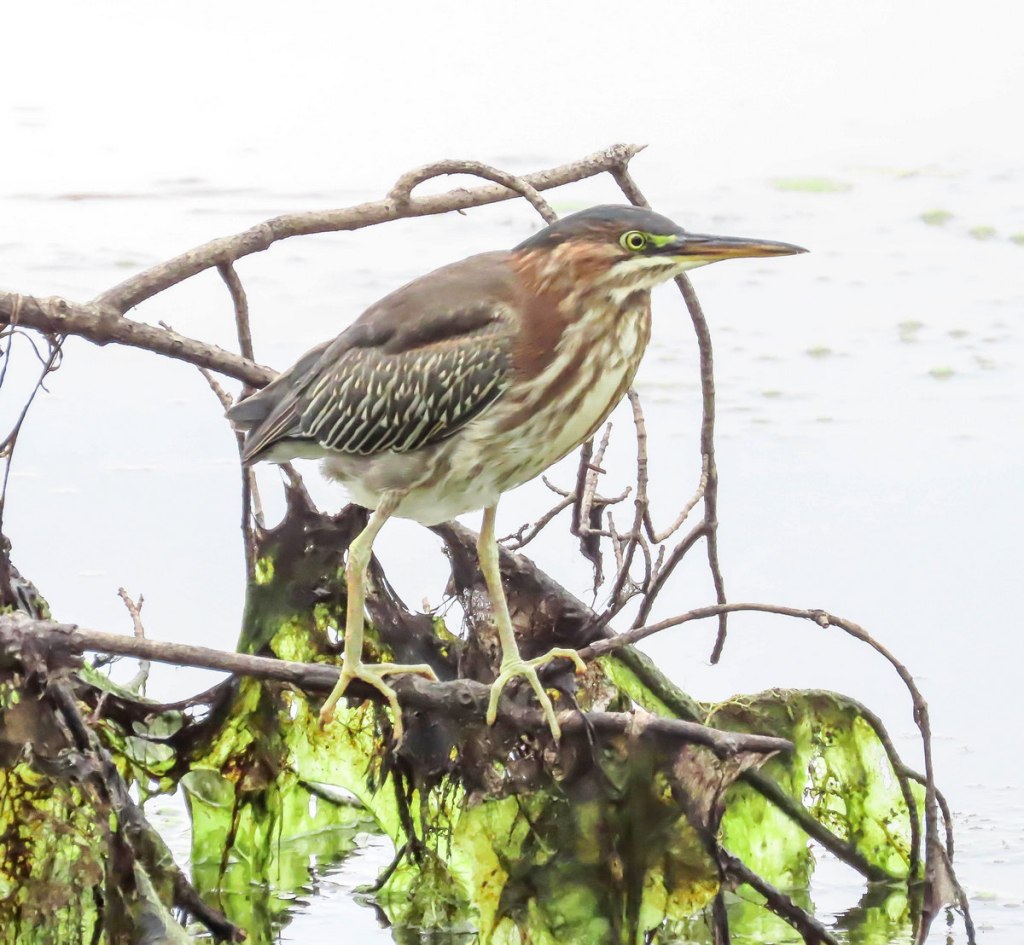
People had told me that there were bitterns here in the wetlands. Bitterns are rarely seen birds and I had no idea what they looked like, so I came home and read about them. What stayed in my mind most of all was how they had stripes and a long neck, so when I saw this bird I thought it was a bittern. I was confused though because it wasn’t a bittern at all, it was a juvenile green heron. I had seen exactly one green heron before and it was an adult in such deep shade my camera couldn’t even find it, so experience didn’t help.

Here is what I believe is a more adult looking green heron with some traces of juvenile color still left on it. At one point there were 5 of these birds in different stages of maturity in this one place and by the time they had all flown away I was confused enough to have not really known what I had seen. So it was back home to do more reading. Green herons are much smaller than great blue herons; just slightly bigger than a crow I think, but like their cousins they can spend quite a bit of time playing statue. If you don’t scare them off like I did, that is.

After all that I felt that I’d had enough of birds for a while but no, here was the World’s Cutest Duck sitting on a log one evening. I took a few shots of it and then, sure it would fly away, I went on looking for other interesting things. This duck was on one side of a tiny pond and I was on the other side. I walked by it several times but it just sat and smiled; the very picture of serenity. The birds I kept running into weren’t behaving like I thought they would and I wondered if maybe this little duck was sick. It was small enough to hold in two cupped hands and cute enough to melt your heart but all I could do was wish it a peaceful night ahead. I still haven’t been able to identify it as anything but a tiny duck.

One of the things I saw while I was stumbling around the duck was this bladderwort; the only one I’ve seen this year. The light was going fast but the camera coped.

I went to a brighter place out in the open where I knew some purple morning glories grow but I was too late and there wasn’t a single open flower. But what beautiful buds! I got out the camera I use for macros, took one shot, and got the dreaded “card full” message. There was nothing to do but try the new camera on them. I doubted it would be able to get a shot of something so small but here it is. I love the way these buds spiral but what really surprised me was the shine. And I hadn’t used a flash.
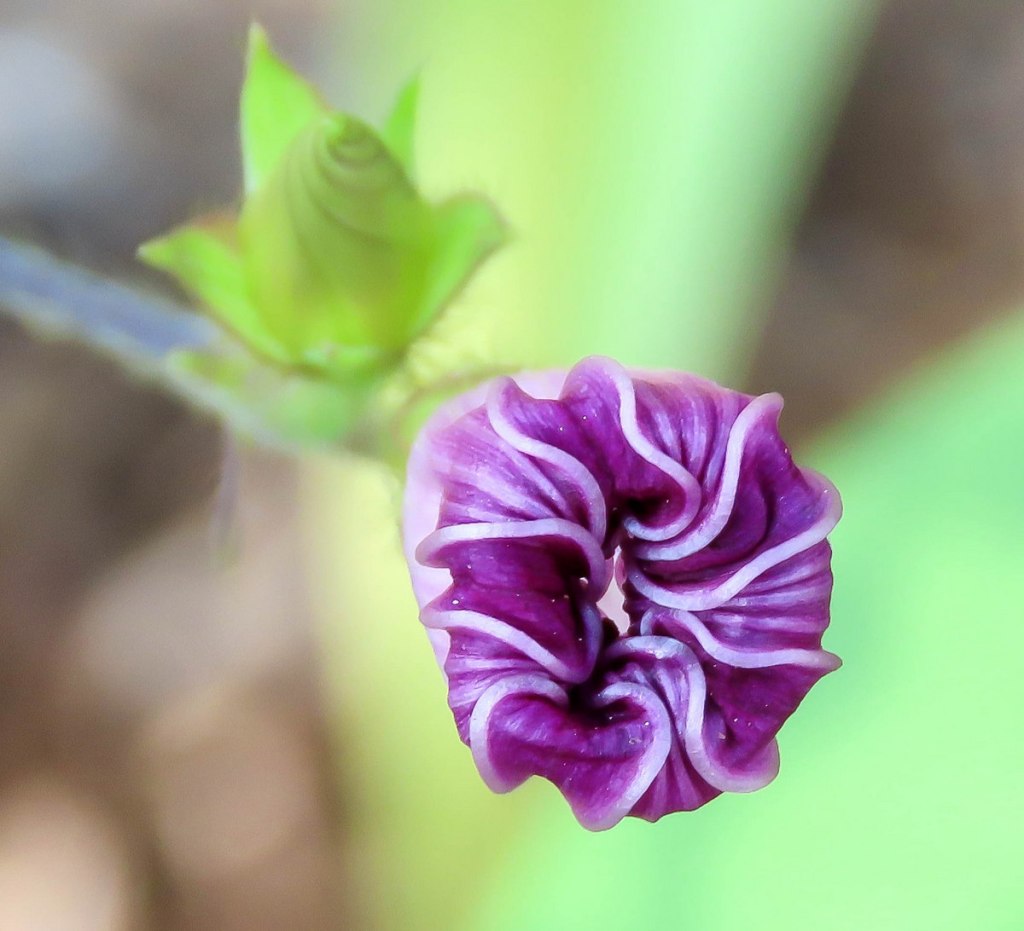
This is what a morning glory flower looks like when it is finished. It kind of falls in on itself. I was surprised that the new camera could get this shot without being in macro mode.

It also got a shot of a hedge bindweed flower that didn’t have pink stripes.

I finally found an emerald spread wing damselfly hanging on to a pickerel weed stem in sunlight, so now you can see their beautiful colors. The new camera did a fairly good job of reproducing them, I thought.
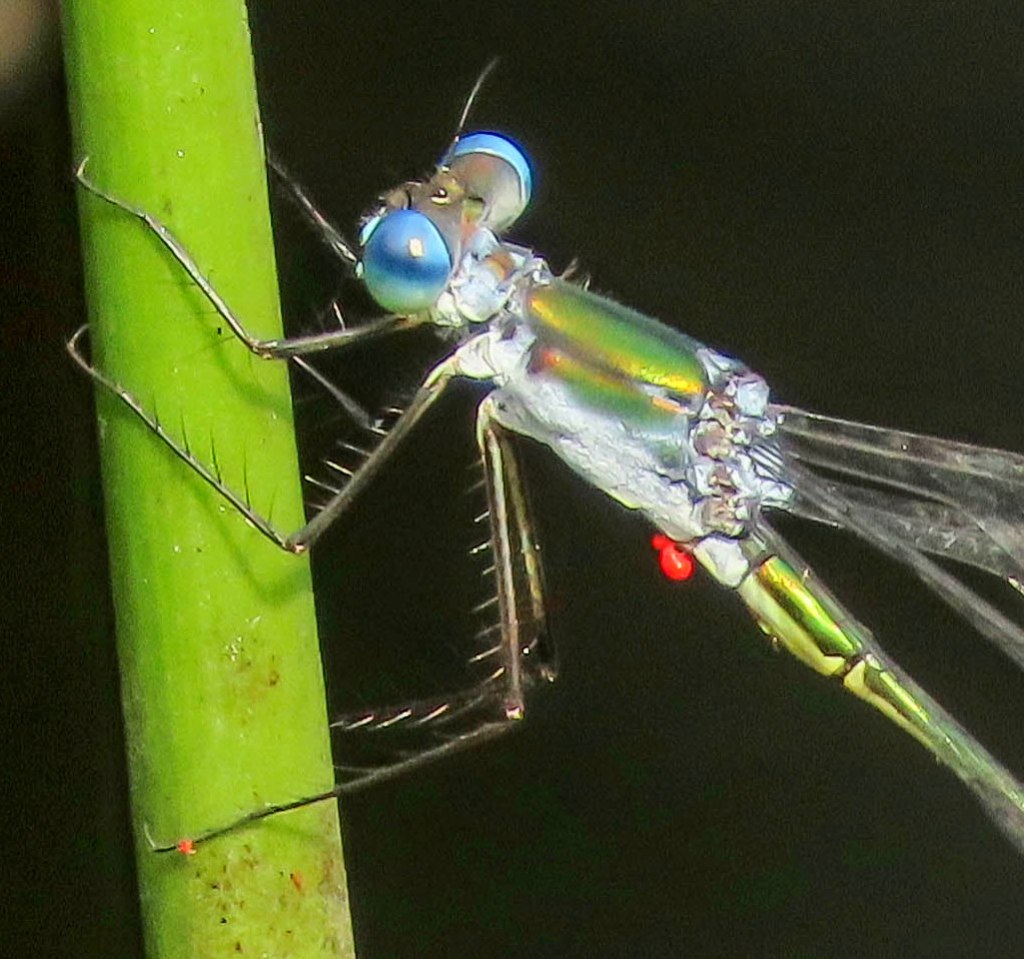
I was able to crop the photo to give you a better look. I like those big blue eyes and that metallic green. I also wanted you to see the tiny red “blob” under its abdomen. It’s a water mite, which is a parasite in the tick family that feeds on the blood of dragon and damselflies. It / they will eventually drop off when the damselfly is over water.

This shot I took a few years ago shows the immature water mites on a banded wing meadowhawk dragonfly. When one organism transports another organism of a different species it is a symbiotic process called “phoresy.” This information on water mites was confirmed by the folks at Bug Guide.net and Kathy Keatley Garvey and the bug squad from the University of California. Thanks also to Ginger Wells Kay for her help.

I was happy that the new camera was able to shoot dragonflies. The first one I tried was this widow skimmer. I chose this photo for this post because this dragonfly was hanging onto some Joe Pye weed buds. In my experience dragonflies don’t seem to perch on flowers that often.

Later on I ran into yet another bird; this time a great blue heron, wading through the weeds in the Ashuelot River. I couldn’t understand how it could wade here without tripping over all the growth but it did. A curious thing happened this year; pickeral weeds lined the river banks and bloomed as always, but then it started raining and didn’t stop. The river got so high that it was far over the “heads” of the blooming pickerel weeds, and it killed them all off. All that is left is the mass of dead leaf stalks seen in this photo.
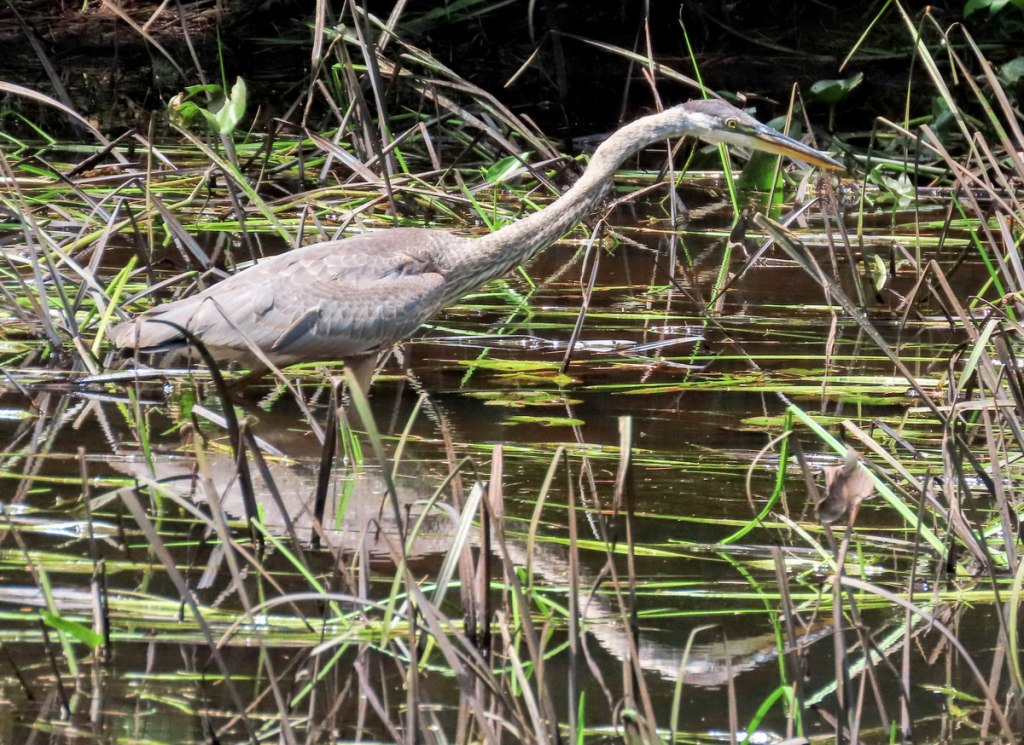
The big heron stuck out its long neck and I thought it was going to make a spectacular catch but instead it froze and stayed that way, as if mesmerized. It seemed like it was ready to play statue, so I thanked it for letting me take photos and left it there staring at its own reflection.

One day I saw a lot of ferns with fern balls on them. Fern balls are created by an insect called a fern leaf roller. The rolled up leaves appear at the tip of a fern frond and look like a ball, and inside the ball are caterpillars of a moth, possibly in the herpetogramma family. The caterpillars pull the tip of the fern into a ball shape and tie it up with silk. Once inside the shelter they feed on the leaflets. Nature is always full of surprises.

Speaking of ferns, here is this year’s example of a royal fern. I like to always show this fern because many people don’t know that it is a fern. I almost always find royal ferns along river and pond banks. They turn a beautiful yellow color in the fall.

The acorn crop looks like it is going to be big this year and I’m so glad that I no longer have to rake them all up.

August is usually the time when our first asters appear. This one is a marsh aster; the first I’ve seen this season. There will be plenty more of them soon. They often grow in or very near the water at pond shores.

The unusual flowers of the ground nut plant also appear in August. They’re very pretty and always remind me of the helmets once worn by the Conquistadors. It always seems odd to me that we have “invented” so many things that have the same form, color, or function as the things found in nature. Nature has to be the inspiration behind many of the things man came up with in earlier times.
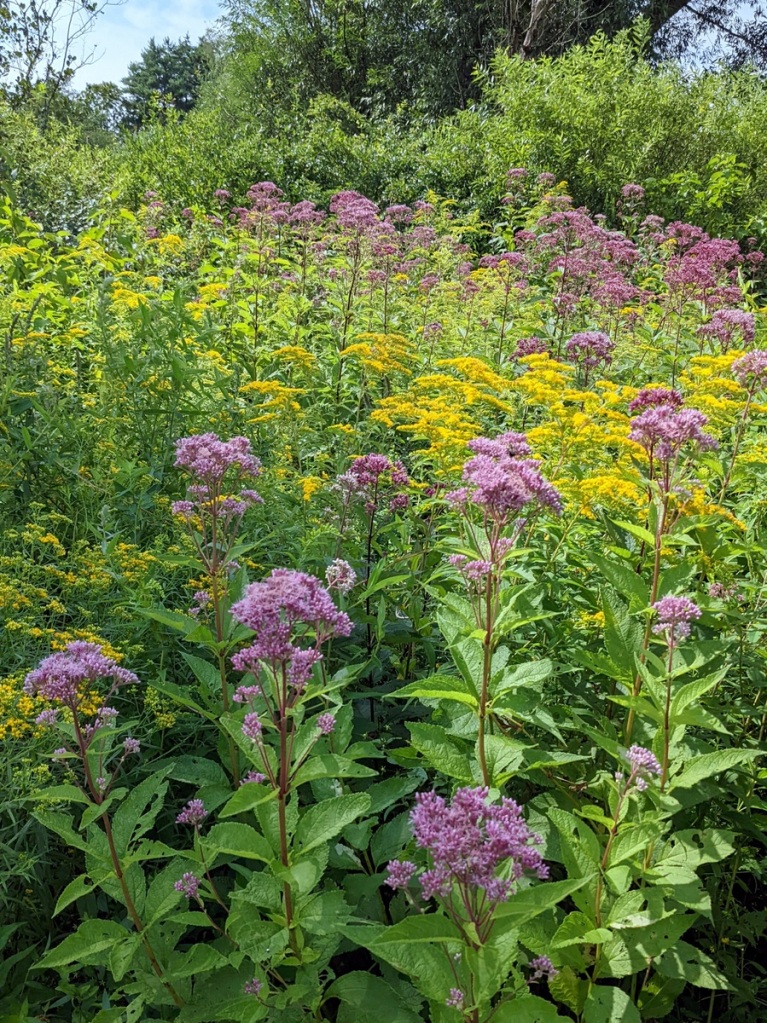
Plants release their seeds to the wind not knowing or caring whether or not they’ll fall on fertile soil, but still they grow into beauty like this. It strikes me that a blog is much the same; you let your words flow freely out into the world never knowing where they’ll land or what they might grow into. All one can do is hope that maybe one day something beautiiful might come from them.
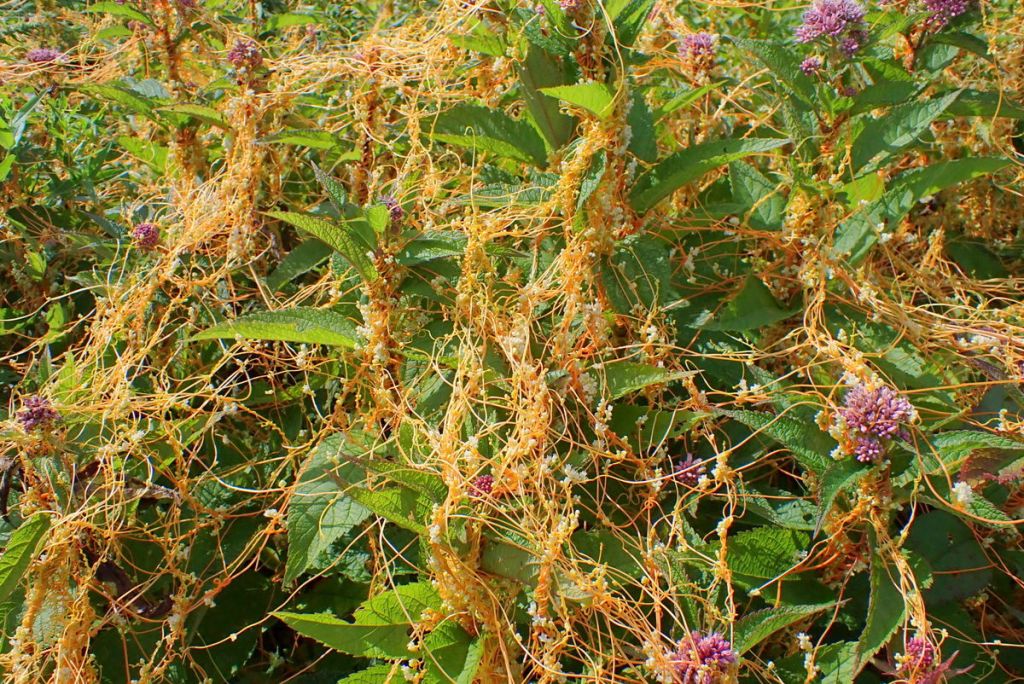
If you come upon a spot where it looks like someone dumped a bowl full of orange spaghetti all over the plants then you’ve found a parasitic plant called dodder. It is an annual plant which, once it starts growing, quickly covers plants in what might look like the silly string that used to come in spray cans. Since it has no leaves it is easily seen.

Dodder doesn’t need leaves because it sucks all the life giving nutrients it needs from its host plant. In this photo taken earlier you can see how the orange stem of dodder, just to the left of the tiny flower, has penetrated and entered the stem of a goldenrod. Once this happens it gets all its nourishment from its host and it no longer needs to contact the soil it once grew from. Out in the field as I found it, it does no real harm but it can severly damage crops and for that reason farmers have given it names like devil’s guts, devil’s hair, devil’s ringlet, hail weed, hair weed, hell bine, pull-down, strangle weed, and witch’s hair. It’s hard to control; all the tiny green spheres you see in this photo are seed pods.

The only bird in this post I’ve tried to find is this cedar waxwing, which I found sitting on a stone in the middle of the river one evening. Many of you wrote in after the last post to say how much you loved these beautiful birds so I thought I’d show another one. It sat in the evening sun waiting for insects to happen by. Due to all the rain there are more mosquitoes this year than I’ve ever seen, so the waxwings won’t go hungry.
In the trembling grey of a spring dawn, when the birds were whispering in mysterious cadence among the trees, have you not felt that they were talking to their mates about the flowers? ~Kakuzō Okakura
Thanks for coming by.